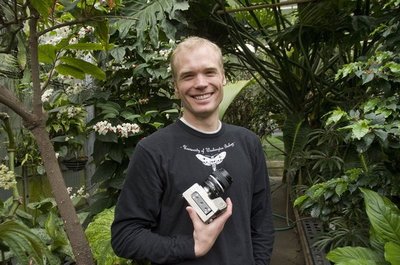May 20, 2010
The frog who failed famously, and the man who captured it on film
This is the story of a frog who tried really hard to catch a dragonfly, and just barely missed — and the man who captured the moment on high-speed film and sent it out to the world.
The man is Andrew Mountcastle, a graduate student about to complete his doctorate in biology at the UW. And the frog is, well, just a frog, whose grasping, clutching, optimistic leap for a juicy meal missed completely — but became a hit on YouTube and landed him on The Tonight Show with Jay Leno.
Mountcastle studies insects in flight, particularly how flexible wings affect an insect’s flying abilities. He’s found that flexible wings can be better than fixed wings for stable flight. (Read an earlier UWeek story about this research here.) He’ll finish his doctorate this summer, and has landed a post-doctoral job at Harvard for next year.
Mountcastle uses high-speed cameras in his work for Biology Professor Tom Daniel’s lab, which provided the Pacific Science Center with films of insects for an exhibit several years back. A couple of summers ago the science center wanted some new insect films, so Mountcastle borrowed a high-speed color camera and commenced shooting.
“I had it over a good chunk of the summer, which is perfect,” he said. “And with insects you can just walk outside, go over to the Botanical Garden and can (shoot) tons of really interesting insect behaviors.”
The camera is “end-triggered,” meaning that “it’s constantly recording and when you press the trigger it just stops, enabling you to capture something that has already happened — as long as you are quick enough to hit the trigger before the memory buffer starts over-writing itself,” he said.
Mountcastle was at the Washington Park Arboretum trying to get footage of insects in flight, near a pond he knew was rich with dragonflies. Many seemed to use a certain branch as a launching pad, so he focused the camera there, and waited for one particular dragonfly to take flight.
“It was taking its sweet time. Something distracted me and I turned to see and I heard this splash in the water. I looked back and the dragonfly is gone and there are ripples in the water. …I pressed the trigger to see what I just missed. I was as surprised as anyone to see what I did.”
What he got you can see to the right — a clear close-up of the frog’s failed leap, clutching air where the dragonfly should be and falling back down, still without his dinner. Mountcastle knew right away that he had something cool.
“It captured my attention for the rest of the afternoon, until the battery ran out,” he said. He shot more film as this singularly determined frog grasped repeatedly for a dinner he never caught. He also got footage of a ladybug’s failed liftoff after a somewhat showy start, as well as many more successful insect efforts.
Failure being a major meme on the Internet these days, Mountcastle put the films on YouTube and sat back to see what happened. Not much at first, but in time, interest began to pick up. “I quickly discovered that folks on YouTube have no problem downloading your video and reloading it on their account.”
The Frog Fail video leaped into the national consciousness when it was shown on The Tonight Show With Jay Leno in a recurring routine called Internet Success and Failure. Leno set up the video saying, “Now, I had a frog and I always teach them, let the food come to you. Not like this frog. This frog went hungry and you’ll see why.” (Watch the segment here.)
“Ah — ah!” Leno cried with a wince as the audience laughed and applauded the video. “‘Like a Michael Jordan of frogs — very graceful as he goes through the air!”
The video has long since gone viral; so far, it has 570,000 views on YouTube.
It’s also making money, as Mountcastle licenses it to various media organizations and nature programs who come calling. In fact, he said, a car company in Spain just bought it for a commercial. So far, the famous Frog Fail video has brought in about $5,000, all of it going to Daniel’s lab, which Mountcastle said is only fitting.
It’s great fun, and helps engage the public in science a bit, Mountcastle said. But it’s more than just that to him.
“I view (high-speed cameras) as time microscopes,” he said. “In the same way that microscopes allow you to magnify space, these allow you to magnify time — to see details of time that we’d never see with the naked eye. It’s a great tool.”
You can learn more about Mountcastle and his work, both fun and serious, online here.

